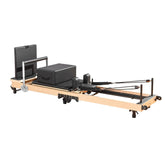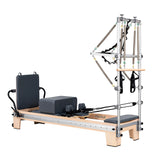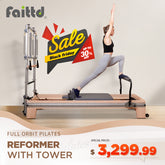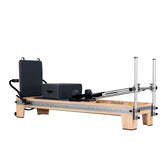Is 20 Minutes of Pilates on the Reformer a Day Enough?
Quick Answer
Yes, 20 minutes of Pilates on the reformer each day can be effective if you focus on maintaining consistency and good form. This short routine can engage multiple muscle groups, boost your metabolism, and enhance strength and flexibility when exercises are well-structured. However, for greater results, consider adding longer sessions (45–60 minutes) a few times a week to deepen these benefits.
Introduction
Wondering if just 20 minutes of Pilates on the reformer each day can actually impact your fitness journey? You’re definitely not alone! A lot of people question whether such a short workout can deliver noticeable results. The key is making the most of that time—engaging the right muscles and keeping your form sharp. Whether your goal is losing weight, building strength, or enhancing flexibility, we’ve got everything you need to know to maximize those 20 minutes.
What is the Science Behind Reformer Pilates Exercises?
Reformer Pilates exercises are a series of movements performed on specialized pieces of equipment called Pilates reformers, which consist of sliding carriages, adjustable springs for resistance, and various straps and bars. These exercises focus on the enhancement of strength, flexibility, balance, and core stability using resistance and support from the reformer to enhance the traditional Pilates techniques.
Reformer Pilates Boosts Your Metabolism
Working on the Pilates reformer can enhance your metabolic rate in an astounding manner. Though it might seem pretty soft, reformer Pilates is a form of an effective way of burning fat and improving metabolism. Its continuous flow movements are quite demanding, maintaining the heartbeat higher and resulting in greater burn post-workout.
Reformer Pilates Engages Your Muscles Effectively
Unlike most conventional strength training, which usually works on isolated muscles, reformer Pilates activates both major and minor muscle groups, including those responsible for stabilization, which usually get ignored. Its effectiveness in enhancing core strength, improving posture, and increasing overall muscle tone has been underscored in various studies. The resistance from the reformer springs challenges muscles through a full range of motion, which leads to better functional fitness—meaning you're not just stronger, but you move better in everyday life.
Overall, the reformer's ability to engage muscles deeply and improve metabolic outcomes makes it a versatile tool for those looking to get the most out of their workouts in a short period.

How to Achieve Your Fitness Goals with Reformer Pilates
Reformer Pilates is a versatile workout that can be tailored to meet various fitness goals, making it ideal for home fitness enthusiasts, those seeking rehabilitation and core strength, and even athlete recovery centers. Here’s how you can effectively pursue each of these objectives:
Lose Weight with Reformer Pilates
For home fitness enthusiasts aiming to lose weight, reformer Pilates offers an effective, low-impact exercise routine that burns calories and boosts metabolism. The continuous flow of movements ensures your heart rate remains elevated, maximizing calorie burn.
- Pro Tip: For better weight loss results, introduce high-intensity intervals by adjusting the resistance settings. Do this at least three times a week. Combining your workout with a proper diet will give faster changes in body composition and can be done in the comfort of your own home.
Build Strength with Reformer Pilates
The reformer offers gentle yet effective resistance training for those into rehabilitation and core strengthening. Progress from basic exercises that engage the core to more complex movements targeting larger muscle groups.
- Pro Tip: For those in rehabilitation or looking to improve core strength, consistency is key. Practice two to three times per week to see noticeable enhancements in muscle tone and strength within four to six weeks. Set progressive strength goals, such as increasing resistance levels, to stay motivated and effectively track your progress.
Improve Flexibility with Reformer Pilates
The reformer Pilates may be used by an athlete recovery center to enhance flexibility, especially in controlled stretching and lengthening exercises of the muscles. Certain movements, like leg stretches and spinal twists, are especially useful for increasing the range of motion.
- Pro Tip: Instruct the athletes to do these flexibility exercises at least twice a week for gradual, noticeable improvement. Also, let them be their own judge and not overstretch. Breath control during sessions will help them ease into the stretches safely for better recovery and performance enhancement.

How to Make the Most of a 20-Minute Pilates Reformer Workout
Maximizing short workouts on the Pilates reformers require smart approaches to exercise selection and time management. Here’s how you can structure an effective 20-minute session:
Optimize Your Pilates Reformer Workout
To get the most out of your limited time, choosing the right sequence of Pilates reformer exercises is key.
1. Warm-up: Do light movements like footwork or small leg circles to activate your muscles and get them ready for the workout.
2. Engage Your Core: Incorporate core-strengthening exercises such as the Hundred or Leg Circles to engage multiple muscle groups at once.
3. Target Major Muscle Groups: Focus on major muscle groups like the legs and back, using routines such as the Short Box Series or Long Stretch.
4. End with Stretches: Complete your session with stretches like Mermaid or Elephant to improve flexibility and help recovery.
5. Follow a Structured Routine: Make sure the workout is balanced—from warm-up, intense exercises, and ending with stretching.
Distribute Your Workout Time Effectively
With only 20 minutes, every second counts. Here's a simple way to allocate your time effectively:
1. Warm-Up (3-5 Minutes): The warm-up will gear your body up for working out in the next 20 minutes. Keep it light with movements that facilitate blood flow and a gradual increase in heart rate to avoid possible injury. Arm circles, jogs in place, light footwork, or soft leg swings are good for loosening joints and muscles; this sets the foundation for a better session.
2. Main Exercises (10-12 Minutes): The bulk of the workout should be given over to main exercises, aiming at strength, stability enhancement, and coordination improvement. Choose a mix of exercises that attack different muscle groups, like planks or leg presses focused on the core, to upper-body exercises such as chest expansions. Make sure any transitions between exercises are made smoothly to keep your heart rate up, thus pushing both cardiovascular benefits and metabolic results.
3. Cool-Down (3-5 Minutes): Conclude your workout with a cool-down period to facilitate recovery and promote flexibility. Incorporate stretches that focus on areas worked during the session, such as hamstring stretches, spinal twists, or shoulder rolls. Cooling down helps reduce muscle stiffness and soreness, and aids in bringing your heart rate back to its resting state, which is crucial for long-term fitness and injury prevention.

Expert Opinions: Is 20 Minutes of Reformer Pilates Enough?
Yes, 20 minutes of reformer Pilates can be beneficial, especially if practiced consistently with proper form and focus. It helps maintain an active routine and offers health benefits like improved muscle performance and flexibility. However, for more significant results, such as increased strength and flexibility, experts recommend incorporating longer sessions (45-60 minutes) 2-3 times a week.
What Instructors Recommend for Getting the Most Out of Reformer Pilates
Doing 20 minutes of Pilates on the reformer every day can be beneficial, especially if you’re consistent and focused. Here’s what professional instructors suggest:
- Consistency is key; even with just 20-minute sessions, doing Pilates daily helps you build strong habits and maintain progress better than skipping workouts.
- Focusing on your form and staying mentally engaged during exercises ensures you get the most out of each movement, enhancing your overall body awareness.
- Keeping your workouts balanced by targeting different muscle groups boosts your overall strength and flexibility, offering results similar to a full workout routine.
- Starting with a good warm-up and concentrating on controlled movements is crucial for achieving the best results and preventing injuries.
According to Paola di Lanzo, a well-known wellness guru, the ideal workout duration is between 45 minutes to an hour. "This duration allows enough time to properly warm up, perform a variety of exercises that target different muscle groups, and cool down effectively," she explains. "A session of this length provides a comprehensive workout, helping to build strength, improve flexibility, and enhance overall body awareness." This structured time also facilitates mental clarity and focus, as it becomes a mini-retreat from the constant demands of daily life. "But more importantly, it also means you have 45 minutes to an hour to yourself, with no phones or distractions." This quiet time is not only good for physical health but also supports mental well-being and provides a much-needed respite from our busy schedules.
What Studies Say About the Benefits of Reformer Pilates
One study had participants complete twelve 60-minute sessions using the Reformer apparatus. The treatment resulted in an improvement in respiratory muscle performance. The training significantly improved inspiratory muscle strength from 116 to 120 pressure and expiratory muscle strength from 75 to 89 pressure.
In another study, over eight weeks, a group of thirty sedentary women aged 30-36 participated in a reformer Pilates program to assess its impact on flexibility, heart rate, and glucose levels. The participants of this study practiced 60 minutes three times a week at a moderate intensity every week. The results were impressive: the average body weight decreased from 63.43 kg to 61.8 kg, resting heart rates decreased, maximum heart rates fell from 112.70 to 109.50 beats per minute, and flexibility improved from 24.7 cm to 26.5 cm. Although glucose levels did not change, these results have underlined the positive contribution that regular reformer Pilates provides in improving physical health-especially cardiovascular fitness and flexibility.
While short sessions are beneficial, especially for beginners or those in a hurry, experts often recommend 2-3 longer sessions per week, which should last 45-60 minutes each, for better results.
How to Implement 20 Minutes of Pilates on the Reformer Practically
Making the most of a short Pilates workout on the reformer requires careful planning and consistent evaluation. Here's how you can effectively incorporate 20-minute sessions into your routine and track your progress:
Set Up Your Weekly Pilates Plan
Creating a structured schedule for your reformer Pilates workouts each week is pretty important. Try to commit to at least three to four sessions a week for consistent, non-overburdening practice of the body. You can take your reformer workout classes on a Monday, Wednesday, and Friday, for instance, to allow other days to rest or cross-train. Make sure every session has balanced warm-up exercises, strengthening of the core, and flexibility workouts.
Track Your Progress
To truly understand your progress and know what changes might be needed, tracking your development is key.
- Setting Goals: Set specific, achievable goals in terms of increased resistance, mastering new exercises, or improved flexibility.
- Keep a Workout Journal: Write down details after every workout: exercises done, resistance used, and personal feelings on performance.
- Visual Tracking: Periodically take pictures or record videos of yourself to observe the change in posture and muscular tone. These visual records will provide extra motivation.
- Digitize your workouts using fitness apps for progress tracking over time, thereby getting insights into improvements. Review every couple of weeks, celebrate successes, and change up the goals to keep pushing yourself harder.
Get the Most Out of Your Reformer Pilates Routine
Twenty minutes a day of Reformer Pilates can really make all the difference in your journey if it is done consistently and with focus. These short workouts are great for engaging various muscle groups, boosting your metabolism, and improving both strength and flexibility. To get the most from these sessions, concentrate on maintaining good form, choosing effective exercises, and flowing smoothly from one move to the next. If you’re looking for even more progress, consider adding a few longer sessions during the week. Start today by setting clear goals and making a workout schedule that enables you to maximize every minute spent on the reformer.





